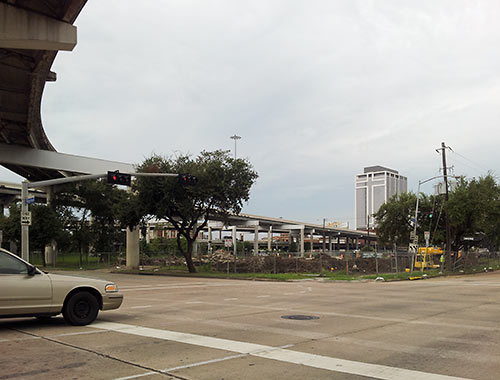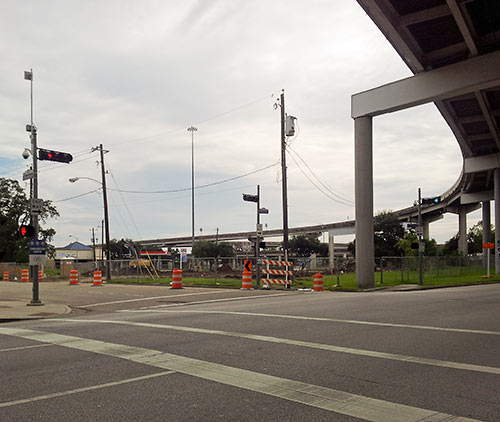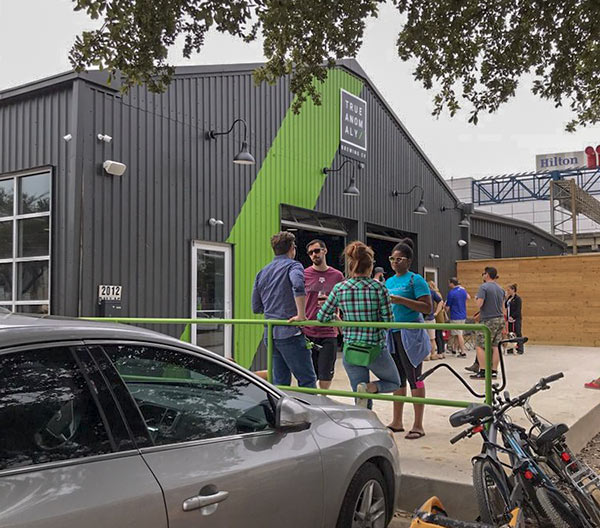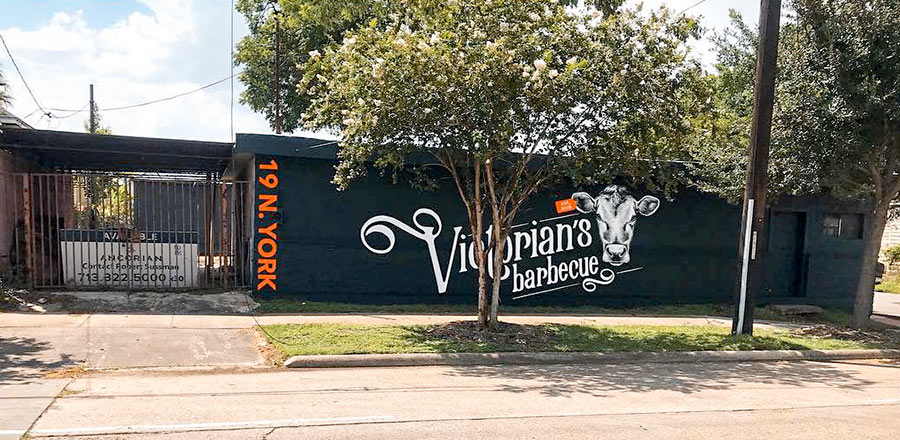
With nary an announcement, preliminary sitework appears to have begun for the 148-unit Hamilton Apartments, on a 1.12-acre lot at the southeasternmost corner of downtown (actually, the southern corner if you don’t pretend, as most direction-givers do, that the downtown grid has no tilt to it). The block, hugged gently by a flying overpass at the intersection of I-45 and Hwy. 59, is surrounded by Hamilton, St. Joseph Pkwy., Pierce, and Chenevert streets.
***

The apartments will sit on top of a 2-level garage podium, according to permit records for the site at 1800 St. Joseph Pkwy. City records from 2012 (PDF) indicate the project’s backers applied for $3 million in funding from an affordable rental housing program administered by Houston’s Housing and Community Development Dept., and was also seeking almost $19 million in low-income-housing tax credits through HUD.
Photos: Marco Hernandez





Wow, all it took was a $3mil subsidy to get some ‘affordable housing’ built in this town.
Bah. We already have plenty of affordable housing in this City. It’s just that most of it is concentrated in areas that have been labeled “bad.”
.
They shouldn’t have needed a $3 million additional subsidy for the Hamilton Apartments, if the project made sense to begin with. And any use of Federal tax credits for new affordable housing on open land in Houston is really a waste – when you consider how desperate many of our existing affordable complexes are for rehabilitation.
.
The Hamilton Apartments are not a project our City really needs.
The term Affordable Housing is being misused by these schemes. There’s PLENTY of affordable hosing further out southesast, northeast, gulfton, greenspoint, and a million other places. Nobody is ENTITLED to live in a place that they can’t afford. These schemes besides stealing taxpayer money via subsidies also steal real estate values from it’s immediate neighbors.
It’s not really “affodable housing”. It’s just that someone else is paying for it.
This is a smart location for subsidized housing. Hopefully the proximity to the best public transit in Houston will serve as an additional subsidy; the two biggest average household expenses should be very affordable for the residents. I’m also thrilled that this is close to a major employment cluster. After all, self-sufficiency should be the ultimate goal barring total disability.
I also like that these residents will be “settlers” in this corner of the CBD. I know some will argue that Section 8 will always dissuade neighboring development, but considering what is already there this project is a step in the right direction. I don’t have an ethical problem with situating these residents in a location that benefits other community interests so long as the project is still a net benefit to them.
Because the City and County are under extreme legal pressure from housing “Advocates,” they pretty much have to subsidize only those developments that can be shown to be in areas which are gentrifying (or are very likely to in the near future), or are within existing higher income, mostly-white-and-Asian areas.
Don’t disagree that we shouldn’t spend taxpayer dollars to fund new “affordable” housing – especially in Houston where there’s so much of it around already, albeit not exactly newly built.
I still think we should ditch the $15k a unit tax credit for new housing Inside the Loop, and institute a City-funded 2% bonus to the Federal LIHTC program for rehab and reconstruction projects. To my knowledge no City has ever built on the federal LIHTC program. I don’t think anyone would sue over that. The lawsuits come from Cities and Counties trying to prevent developers from using the tax credits. This would be doing the opposite.
.
I agree with Alex. section 8 housing has a terrible reputation – the result of noted failures like Pruitt Igoe and Cabrini Green. But new section 8 housing, built with LIHTC credits, is a huge improvement. In many cases the only way you can tell it’s section 8 housing is that it has a daycare/classroom on site instead of a business center, and a splash pad instead of a spa swimming pool. In places like Westwood, these projects would be a MAJOR improvement over the housing that’s already there. And in Brays Oaks, they’ve found that section 8 rehabs actually help stabilize, and slightly improve, local property values.
ZAW: we have fixed up some heavily run down areas east of 288. Making once boarded up apartments available for lower income renters*. This is near employment centers and public transportation and inside the loop.
.
Where is my money?
.
Note the apartments are low priced but we don’t screen to make sure they’re only low income renters. We could have millionairs renting for all I know/care (but I doubt it). However, we don’t accept section 8 or anything else so I guess that’s why we’ll never see these credits or handouts. I want no part of section 8 or any vouchers. Not because of the tenants, but because dealing with those organizations is terrible. We used to take HUD VASH for vets but had to stop that because the paperwork just wasn’t worth it vs renting directly to the end user. For each renter there is gobs of paperwork. Everything is paper/fax/forms. It’s a nightmare.
Zaw: and there *IS* a big difference with section 8 properties when you go to insure or sell. Insurance companies will charge more (lowering your NOI) and buyers will want to discount the property (requiring you sell at a higher CAP). Those two factors often kill any advantage of “mailbox money”. Add the extra time and labor with dealing with the government for your rent and you’ll see why so many people don’t bother to take it.
.
It’s a shame they make the process so terrible. The result is making sure that in demand areas will never take it (pushing section 8 renters to undesirable areas) and people that take section 8 charge more than the market would otherwise have to pay (to make it worth doing). This means tax payers pay more than we would otherwise have to.
.
If they made taking section 8 easier, the renters would get better areas and tax payers would pay less. Another example of rules to “protect” renters doing more harm than good.
This is also an example of the insanity in the housing market right now. This is an otherwise awful piece of property but it is an attractive location for apartments in todays crazy market.
ZAW: What is this $15K subsidy for residential inside the Loop? I’m not aware of anything except the subsidy program for new residential in downtown only (so far), which is set to that amount.
As I said earlier, the “Advocates” hold a strong legal threat over the City that prevents the City from doing as you describe, unless such properties are located in a predominantly white/Asian or high-income area, or an area that is demonstrably transitioning to such an area.
I would assume that Garnet Coleman is an example of one such “Advocate”, perhaps among others.
You’re right, Planner. There are people who are quick to sue when local officials try to block the construction of affordable housing – and HUD is quick to help them. (Whether it’s the affordable housing advocates who are really behind these suits is questionable, however – it seems to be the developers whose housing projects are blocked that drive the lawsuits). And you’re right that HUD’s latest policy is to turn it’s back on poor neighborhoods and try to force unwanted, unnecessessary subsidized housing on middle class areas.
.
That’s precisely why I came to the idea of a 2% bonus for LIHTC! The lawsuits come about because cities overtly try to block the construction of subsidized housing. This bonus actually ENCOURAGES the construction of affordable housing – just not on open land. There’s a chance someone at HUD might take offense, and write a nasty memo or something. I guess there’s a chance someone could try to sue. But I just don’t see it. The bigger chance is that it could ignite some ill-will in neighborhoods that want existing substandard housing demolished and not rehabbed using subsidies. But as I’ve learned first hand, that opposition can be overcome if the people doing the rehabs really understand what the problems are and address them. Done right, it’s a win-win for everyone: middle class neighborhoods, housing advocates, poor neighborhoods, and affordable housing developers.
Most of all the 2% bonus to LIHTC could be a win for the poor. They will get more decent, affordable units. More than that: poor people who don’t live in subsidized housing (who are neglected under current HUD policy) will benefit from safer, cleaner neighborhoods.
Some of the comments on here remind me of lines from A Christmas Carol. Boy, have we come a long way from the 1800’s. I am always amused that everyone who has obviously “had it easy” assumes that everyone who hasn’t is somehow always at fault and certainly doesn’t deserve to have any choices for where they live. True, I can’t buy in River Oaks, but I am also not being forced to live in some bug infested complex in SW Houston. By the way, the amount of money that comes out of YOUR WALLET for low income housing is so insignificant as to be laughable. You waste more on a latte at Starbucks or on the gallon of gas you consume sitting in the drive-through waiting for that latte.
@ Niche: No, the “Advocates” are statewide organizations. The head guy of one of them actually just won a “Genius Grant” from the MacArthur Foundation. They have successfully sued the State of Texas THDCA in the past over allocation of tax credit projects, charging that those credits should only be used in areas where it can force income and ethnic mixing. The state is pretty much in terror of these groups now, and the City of Houston and Harris County are as well. These groups have also played a huge role in the allocation of “Disaster Recovery” funds from the feds intended to fund replacement or improvement of public and affordable housing.
SJH: your statement hits on the reality of Houston’s affordable housing problem, which is exactly what I said before: We don’t have a shortage of affordable housing per we. Our problem is that the affordable housing we do have is in bad shape, and in areas where there’s a lot of other affordable housing that’s also in bad shape.
.
HUD’s approach, and what you seem to be after, is to try to force new affordable housing on middle class neighborhoods. It’s great for the tiny fraction of poor people who win the Housing Choice Voucher lottery and get to move to neighborhoods they could never otherwise afford. But it does absolutely no good for the majority of the poor, who are still stuck in those “bad” neighborhoods. (Fortunately, here in Texas, we have TIRZs and Special Management Districts that are doing some good for those neighborhoods and the people in them, but I digress.)
.
Planner: The housing advocate you’re talking about didn’t sue over exclusionary zoning or the usual battle tactics that towns use against affordable housing. John Hennenbrenner’s lawsuit was simply to rebuild existing housing that had been damaged by Hurricanes Dolly and Ike. In fact, I’ll bet he would actually like the idea of using 2% LIHTC bonuses to help rebuild damaged housing.
ZAW: You are correct about the Ike / Dolly issue, but what I’m referring to is that he sued TDHCA over the way tax credits for low income housing were being distributed, alleging that it was unfair to allocate them to projects in already low income and Black/Hispanic-dominated areas, because that would further the concentration of poverty and ethnic segregation. He was successful, so now affordable housing $ from the feds used in Texas are subject to a “Consent Agreement” to avoid this situation. If the City of Houston tried to use public affordable housing funds to provide affordable housing in Sharpstown, he and other quite likely would be on the City’s case about trying to concentrate low income people of color in an area already full of low income people of color.
Few complain about subsidized housing for the rich (Downtown Living Initiative). Many complain about subsidized housing for the poor.
Typical.
ZAW, don’t put words in my mouth. I said nothing about forcing low income housing on those poor middle class neighborhoods (heaven forbid!!!!). That is your belief. I for one, don’t work for HUD, so I don’t assume to know there methods or strategies. My comment was about the general somewhat elitist reaction toward and simplification of a significant and growing problem (especially as the middle class continues to decline….downward).
Fair enough, Planner. Still, I don’t think anyone at HUD is aware of the real issues facing housing in Houston.
.
The national goal of racially, economically mixed communities – and it’s a laudable goal – can’t be reached with one-size-fits-all solutions. In other cities, exclusionary zoning has separated affordable housing from middle class and wealthy neighborhoods. But here in Houston, we often have agglomerations of older, now-affordable apartment complexes that are immediately adjacent to middle class neighborhoods. At the same time, we have far fewer limitations on new construction than other cities – so there is a constant new supply of housing and it all but ensures a ready supply of older, affordable housing. But the catch is that there’s no safety net to ensure habitability in that older, now affordable housing.
.
Ihope someone in HUD’s local office read Susan Rogers piece about the “New Projects” in Cite Magazine – but there’s no guarantee they did. It offers wonderful insight into the issue.
@Mike
Actually I would complain about both. Given the large stock of relatively affordable housing we have in the market, I’m not sure this kind of project makes a lot of sense. I would be more interested in the rehab type projects you are discussing.
@sjh
So what if I waste more on a latte at Starbucks. Who empowered you to decide how my money is spent? Sure, each individual use of govt money maybe small but over time they accumulate. And, as a former president once said, “The closest thing to eternal life on earth is a government program.” I wouldn’t mind seeing a federal sunset act like we have in Texas so some of these agencies would have to justify their continued existence.
Txcon, please, have all the latte you want. Sit in line as long as you want. As a rugged individual, you are entitled! And by the way, there is no guarantee that sunset legislation gets rid of inefficient programs. Politics has nothing to do with efficiency, just what is popular at the moment.
city of houston acting very provincial in it’s planning. other small and large cities have prohibited residential and commercial buildings without conveniences on ground level such as restaurant, dry cleaning, bank, etc etc. this cuts down on traffic, creates more neighborhoody feel, and reduces crime. houston should not allow one more darn apartment building without this. wake up planning and annise. this still creates the tax revenues you want so badly, but creates a better city and saves costs of re-doing these 3rd-world streets that keep breaking our rims and axles
spam much?
@Niche–as opposed to one of your oh so scholarly missives in which your point could be made in 1/3 of the verbiage?
You can read what I write or not, that’s your prerogative. I don’t need you to like what I have to say or how I say it. However, I don’t just copy and paste to every vaguely related article as this guy did. This is spam. Its asinine.